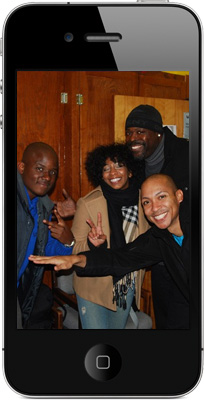
In response to his local newspaper’s efforts to foster conversations around race, an Atlanta-area man thought it fitting to detail his experience riding Metropolitan Atlanta’s Rapid Transit Authority, or MARTA, from his largely white suburban neighborhood through the Black part of town and, finally, down to the airport.
Melton Bennett, a resident of the Atlanta suburb of Cumming, penned the article “On the Red Line: A Daily Racial Transformation on MARTA” this week as part of the Atlanta Journal-Constitution’s new series called “Re: Race, an AJC Conversation.” According to the paper, its new reporting project is purely devoted “to covering both the tensions and the opportunities created by racial and ethnic change in Atlanta and Georgia.”
Bennett was just one of many readers who responded to the paper’s request for residents to “talk about a time when they felt like an outsider.” For him, that time was when he rode the MARTA from his white neighborhood to the airport.

Essentially, the further south the train traveled, the Blacker and scarier its passengers got, according to Bennett. He went on to disparage the African-American travelers, commenting on their “poor grammar” and impromptu rap performances “replete with phrases about violence, sex and race.”
For Monifa S. Seawell, a board-certified forensic and adult psychiatrist, the AJC fell well short of its goal of bridging the racial divide. Instead, it exposed some deep-seated racial biases.
Here, she offers her response to the questionable article:
The Atlanta Journal-Constitution is aiming to facilitate dialogue about issues pertaining to diversity and race through an initiative called the “Re: Race, an AJC Conversation.”
On April 26, 2017, the project featured a narrative by a white Cumming resident, Melton Bennett, titled On The Red Line: A Daily Racial Transformation on MARTA. In this piece, Bennett discusses his experience riding the Red Line of the MARTA train “from the mostly white northern suburbs down to the airport.”
According to Bennett, the suburban whites on the MARTA train exchange “uncomfortable looks” out of fear “the Black kid dressed like a gang member is going to sit next to them.” Black people on the train break out into “an impromptu hip hop performance” and begin using “poor grammar and offensive profanity.” He wonders if Black passengers are behaving this way out of a sense of obligation to “exhibit some cultural difference to a captive [white] audience to make sure they are seen and heard.” But alas, Bennett lets readers know that all is not lost — he is able to “hear the pain in the rap songs and conversations” of the Black passengers. He concludes by pondering “what MLK Jr. would like to have experienced on the MARTA train in 2017.”

Bennett attempts to offer a thoughtful commentary on race but ultimately fails in this objective. Instead, what the article successfully does is draw attention to three troubling racially biased thought patterns that are prevalent in society: the centering of whiteness, the normalization of whiteness and the upholding of MLK as the moral standard for Black behavior.
1) The centering of whiteness:
Bennett questions if Blacks on the train purposely behaved in certain ways because they wanted to gain the attention of the small number of “captive” white passengers. This is an example of the centering of whiteness — the positioning of white people’s feelings, opinions, experiences and perceptions at the center of discussions and analyses on Black people. Rather than analyzing the Black passengers’ reported behaviors using a culturally sensitive lens, the author instead places his whiteness at the center of this analysis and formulates hypotheses about Blacks based on how their actions make him, a white man, feel.
2) The normalization of whiteness and the perception that people who deviate from white cultural norms are pathological:
The article implies that suburban whites represent the cultural norm. This is an unfortunately common societal belief. When whiteness is held up as the idealized standard, the further one’s behavior, appearance, lifestyle choices or linguistic patterns deviate away from it, the more primitive they’re deemed to be and the less societal value they are thought to have. This narrative was present throughout the article.
3) Upholding MLK as the moral standard by which Black behavior should be measured:
At the end of the article, Bennett gives a nod to Martin Luther King Jr., wondering what Dr. King would have liked to see on the MARTA train. Given that the article focuses heavily on the author’s perception that Black city folk were misbehaving on MARTA, the MLK reference can reasonably be interpreted as a way to call out Black people for not behaving more like a sanitized version of Dr. King. Ill-placed MLK references such as the one made by Bennett are also unfortunately common and problematic. Constantly telling Black folks to think about what Dr. King would do, say, think or want not only erases the complexity of who MLK was, but it also is frequently a thinly veiled attempt to guilt Black people into behaving in ways that won’t disrupt white comfort. This, ironically, is the exact opposite of the ideologies Dr. King advanced.
A desire to unearth the roots of racial divisiveness is an honorable objective. Unfortunately, with the publishing of Bennett’s article, The Atlanta Journal-Constitution has failed miserably in this task. Hopefully, future contributions to their Re: Race reporting project will be more closely aligned with their stated goals.
Monifa S. Seawell, M.D, is a Board-Certified Adult and Forensic
Dr. Seawell is an expert in forensic psychiatry, adult psychiatry and Black mental health. She maintains an active practice in Atlanta.
Twitter: @blackpsychiatry










More Stories
‘Let It Be Known’ Dissects Racism in Sports, Black Resistance, and the Evolution of Journalism – BlackPressUSA
Civil rights leaders alarmed after bible and other artifacts are removed from Smithsonian African-American museum – The Independent
Collateral damage: How Trump is hollowing out the Black middle class – Stocktonia